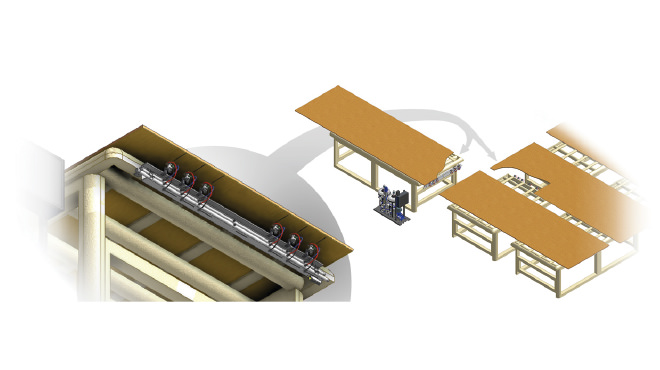New Nail Line Marking System Eliminates Rework, Saves OSB Manufacturer US$94,500 Annually
New Nail Line Marking System Eliminates Rework, Saves OSB Manufacturer US$94,500 Annually
Problem:
A manufacturer of oriented strand board needed to improve its nail line marking system. The existing system applied a black ink solution to the underside of the OSB using solid stream nozzles, which frequently clogged. That left gaps in the nail lines which had to be reworked. A sticking float valve frequently overflowed the system’s mixing tank, creating a messy work area. Chronic overspray added to the mess.

Solution:
A PanelSpray®-NM Nail Line Marking System from Spraying Systems Co. solved the customer’s problems. Easily integrated with the existing conveyor lines, the system includes an AutoJet® spray controller with a convenient touchscreen HMI and 27 1/4JAUCO air atomizing spray nozzles with clean-out needles. The system applies nail lines to the underside of each large OSB panel as it passes over the header-mounted nozzles in the process of being cut into 4’ by 8’ (1.2 m by 2.4 m) sheets.
The AutoJet® Model 2250+ spray controller actuates the nozzle’s clean-out needle and applies a brief pulse of atomizing air at the end of each spray cycle to clean the spray orifice. The result: a precise solid stream spray pattern and clog-free performance.
The PanelSpray-NM Nail Line Marking System uses two tanks – a concentrate tank, typically supplied from a tote, and a day tank where the ink concentrate is mixed to specifications. Mixed ink from the day tank is constantly recirculated from the spray headers back to the day tank to maintain a consistent mixture and keep solids in suspension, further reducing the chance of clogging.
Results:
The new system eliminated the need to rework incomplete nail lines and has cut the manufacturer’s ink consumption by 50%. Additionally, time spent on cleanup during regularly scheduled maintenance shutdowns has been reduced from 16 hours to 2 hours. Together these factors provided a payback period of about one year.
Beyond that, the major reduction in daily and periodic cleanup needs has greatly reduced the amount of absorbent material being discarded and sent to the landfill, complementing the company’s sustainability initiatives.
For complete details of this case study click here to see the PDF version.

